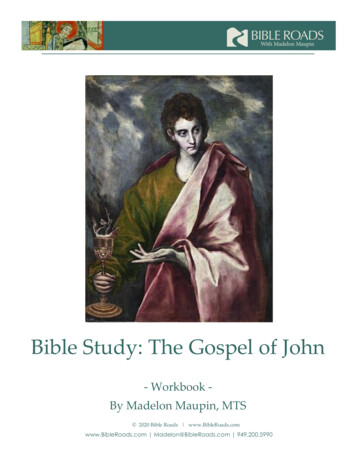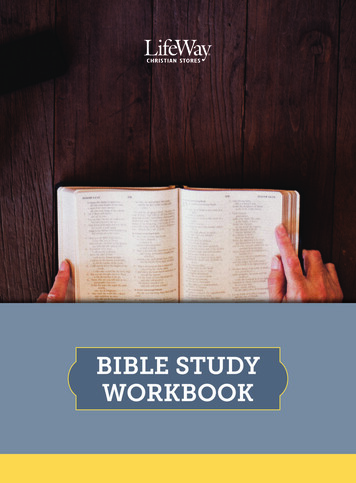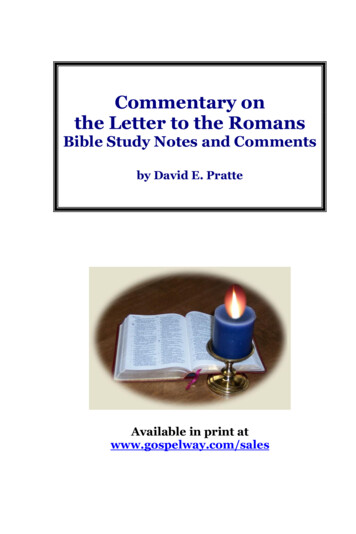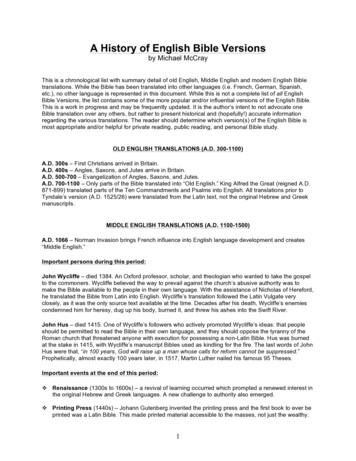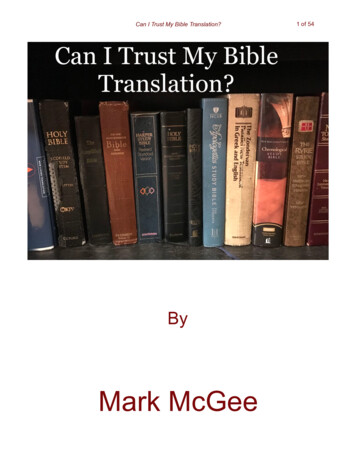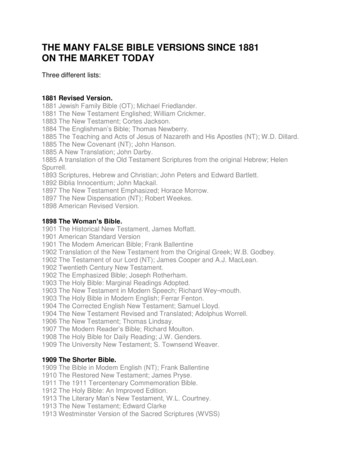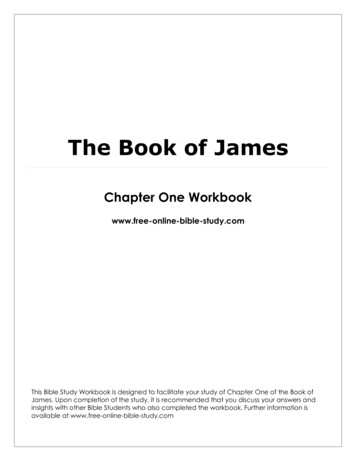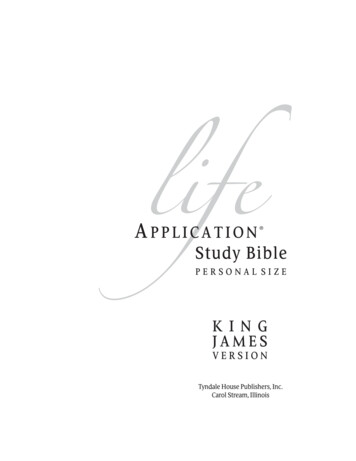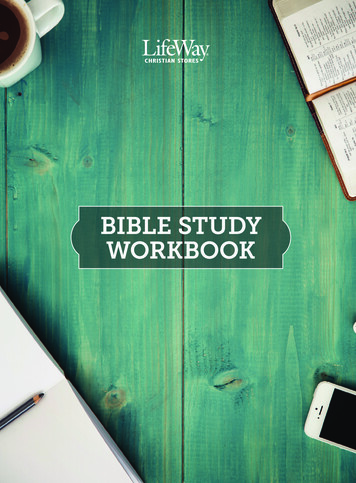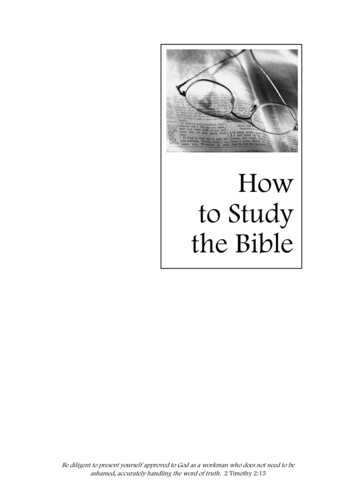
Transcription
How to Study the BibleHowto Studythe BibleBe diligent to present yourself approved to God as a workman who does not need to be 1ashamed, accurately handling the word of truth.Page2 Timothy2:15
How to Study the BibleTable of ContentsNotesGeneral introduction . . . . .3Hermeneutic approaches . . .4-10 Allegorical Method . . 4 Literalistic Method .5 Naturalistic Method . . . 6 Devotional Method . . . .6 Ideological Interpretation . . . . 7 Grammatical-historical Method . .8Introduction to Studying the Bible . .10Timeline of Biblical History .13Steps in Bible Study 15-32 Observation . . 15 Interpretation . .19 Summarisation . . .26 Evaluation . . . .29 Application . . . . 30Charts . .31-35 Procedures in Bible Study .31 Specific Things to Observe 32 Parts of Speech . . . 34 Theological Pyramid . . . 35Page 2Page 2
How to Study the BibleNotesGeneral IntroductionIn our world today, churches are finding many shaking foundations uponwhich they are presumably building the church. All over this planet, weare facing two threats that could destroy the biblical basis for ministry:The first threat is that of pragmatism. Pragmatism is thephilosophical system that assumes that every truth or idea haspractical consequences and that these practical consequences are acritical test of its truthfulness. Some pragmatists add that there arenot transcendental sources of truth therefore truth and values arerelative to their usefulness to either individuals or societies. Inessence we are talking about the elevation of methodologies as thebasis for church growth and development. This philosophicalapproach to building the church may create large crowds, but itdoes not develop God-honouring, holy-living, biblically literate,Christ-centred, Spirit-led believers. The lure of numbers andrecognition has a strong pull. The end result is not what Goddesires from our churches.The second threat is that of syncretism. Syncretism is the attemptto assimilate differing or opposite doctrines and practices,especially between philosophical and religious systems resulting ina new system altogether in which the fundamental structure andtenets of each system have been changed. Syncretism of thegospel occurs when its essential character is confused withelements from the culture. In syncretism, the gospel is lost as thechurch simply confirms what is already present in the culture.One man has said that it is not a problem when the boat gets in thewater; the problem is when the water gets in the boat. Syncretismcomes from a movement toward tolerance and acceptance. Theseare biblical concepts to be sure, but if they are applied in avacuum, without proper biblical truth, they become syncretistic innature and we find the doctrines of repentance, grace, andsalvation virtually non-existent.No matter what culture you are part of in the world, you can see evidenceof these two threats. Paul saw some of the same things happening in hisday that we see happening in our day. His answer was to preach the word.God‟s word must be the only standard and foundation upon which base ourministry. John 17:17 tells us that His Word is truth. God‟s word isestablished in heaven. It provides us with a consistent, solid foundation.But do we know the truth? The question must not be misunderstood asasking if we have the Bible. We definitely have the Bible. It is a book thathas stood the test of time and has been proven time and time again to bePage 3
How to Study the BibleNotesinerrant and infallible. The real question then has to do with ourknowledge of the Bible. Have we come to a place where our study andinterpretive skills are developed enough so that we can confidently say thatwe KNOW the truth, which is the Word of God, which is the Bible?The science of interpreting the Bible is knows as hermeneutics. It comesto us from the Greek verb hermeneuo which means to interpret. Below aretwo terms which are closely related to the science of hermeneutics: Exegesis which comes from the Greek word exegeomai meaningto draw out or the lead out. Applied to the Bible it refers to theprocess of critical analysis of a given biblical text which producesdirect logical conclusions. In exegesis, the passage speaks foritself and consideration of context, time and purpose of writingmust be taken into account.Eisegesis comes from the Greek word eisegeomai describes the actof imposing a meaning onto a text. It is often described as reading“into” the text rather than getting the meaning “out of” the text.Hermeneutic MethodsThe field of hermeneutics involves a few basic hermeneutic assumptions,approaches or methodologies:The Allegorical Method History - This method was used by many 2nd & 3rd centurychurch fathers. It was established as the preferred method ofinterpretation by Augustine and was dominant in Catholicismthroughout the Middle Ages. Definition - The literal meaning of the text is either, not the truemeaning, or only one of many meanings. The elements of eachpassage have a corresponding spiritual reality which is the "real"or ultimate meaning of the passage.oOrigen interpreted Noah's Ark to have 3 meanings (literal,moral, and spiritual) to correspond to man's body, soul andspirit: salvation from the Flood, salvation of the believerfrom a specific sin and salvation of the church throughChrist.oPopes used this method to uphold papal supremacy.Innocent III taught that the two great lights in Gen. 1 referto the order of authority on earth. Thus, the sunsymbolized spiritual authority (i.e., the pope) and themoon symbolized civil authority (the emperor). BonifaceVIII referring to Luke 22:38 taught that the two swordsPage 4
How to Study the BibleNotesheld by the disciples meant that the apostles wereauthoritative in both the secular and spiritual kingdoms. Why This Method Is UnacceptableoSince there is no objective standard to which theinterpreter must bow, the final authority ceases to be thescripture and becomes the interpreter. Whose allegoricalsymbols are right? This question leads to theestablishment of a church hierarchical authority whicheffectively replaces Scripture as the true locus ofauthority.oAllegorical interpretation is only rarely seen in scripture(Gal. 4:21-31; 1 Cor. 10:1-4). Parables are usually notallegories.oAn even more extreme example of this kind of overinterpretation is numerology. In numerology, numbers inthe Bible (whether actual numbers, or the number ofletters in names and passages) are seen to hold secretsymbolic messages. There is no warrant in the Bible forthis kind of interpretation. It should be avoided at alltimes.The Literalistic Method History - This method was used by the Jews after the BabylonianExile. It is also used by extreme fundamentalists and many cults(Children of God, Jehovah's Witnesses, Mormons, etc.). Definition - Every word is taken absolutely literally includingfigures of speech and symbolism. Historical background isconsidered unnecessary and ignored. Any deviation from this ruleis regarded as sacrilegious. oMormonism teaches that God has a body because ofreferences to God's "eye," "hand," etc. However, see Ps.91:1-4. Does this mean He also has feathers and wings?oRoman Catholic interpretation of Lk. 22:19 leads to thedoctrine of transubstantiation. However, does this alsomean that Christ is a door (Jn. 7)?oJehovah's Witnesses use Col. 1:15 to prove that Christ wasa created being. But “first- born” was also used to refer tothe inheritor of the family estate (Num. 21:15-17).Why This Method Is UnacceptablePage 5
How to Study the BibleNotesoSubscribers always use it selectively (see the aboveexamples).oIt makes scripture unintelligible, contradictory, andunlivable (i.e., Lk. 14:26).The Naturalistic Method History - This system arose during the Enlightenment (18thcentury). It is used by old-line liberal theology as their basichermeneutic. Definition - The naturalistic world-view (i.e. the universe is aclosed system of cause and effect) is the standard by whichscripture must be interpreted. Scripture becomes intelligible onlyas ancient man's attempt to explain nature. It also assumes thatreligion has evolved through several stages which can be used todate the material in the Bible. Miracles are rejected as primitiveexplanations or myths. Why This Method Is UnacceptableoIt makes an unproved world-view the final authority.oThe attempt to separate the historical from the“legendary” has been proven to be impossible.Devotional Interpretation History - This method grew out of the post-Reformation as areaction against sterile creedalism. This is the systemunconsciously used by most Christians today. Definition - The devotional method focuses almost exclusively onwhat is personally applicable and edifying. It tends to ignorecontext, historical background, and other important interpretiveprinciples. Why This Method Is UnacceptableoDevotional interpretation can easily lead to uncontrolledallegorizing and inaccurate interpretation througheisegesis.oWhile the goals of this approach to Scripture arecommendable, a critical analysis of the text has to precedethe devotional question. Devotional significance must bePage 6
How to Study the BibleNotesbased on an accurate interpretation of the word of truth, itcannot be the basis for that interpretation.Ideological Interpretation History - The "New Criticism" advanced in the 1940's began tofocus on text and reader rather than on the author. The author hasno more authority over the meaning of the text than anyone elsebecause: 1) He didn't realize his own bias at the time he wrote, and2) We have no way to read his mind and thus know his intentions. Definition - Ideological interpreters approach the Bible looking formaterial relevant to their ideology. They usually are open aboutthe fact that they have an agenda, and usually claim they arecorrecting oversights from earlier years by focusing on their areaof interest. Most ideological readers also entertain a reader-centredhermeneutic. They are sceptical about ever knowing what theauthor intended to say, and focus instead on how the text affectsthe modern reader. oFeminist Theology - seeks to study women in the Bible,and to demonstrate that the more enlightened speakers inScripture were anti-patriarchy. In general, their studies areintended to explode the myth of patriarchy and to uncovercruelty to women. Some advance gender-neutral languagein translation, including God as "she," sometimes based onlady wisdom Prov. 1:20ff.oMarxist or Liberation Theology - seeks to show that thetrue intent of God in the Bible is to teach that poor andoppressed classes should be liberated from theiroppression by the love of God. Tends to interpretredemptive language in terms of economics and politicalpower. They see class struggle in much of the conflict inthe Bible.oDeconstruction - Postmodern readers see themetanarrative (overarching story that provides the basis ofeverything) of the Bible, not as teaching liberation, but asa tool used for exploitation. The Bible is propagandaintended to show why patriarchy is appropriate. Theauthors of Scripture sought to legitimize the status quo ofsociety by teaching people to obey their authorities. Theyalso sought to justify aggrandizement of the state of Israeland the subjugation of neighbouring peoples.Why This Method Is UnacceptablePage 7
How to Study the BibleNotesoMost systems seek to decrease reader bias through theapplication of rules. These rules introduce objectivity tothe interpretive process, according to traditional methods.Ideological and reader-centred methods hold thatobjectivity is never possible, because the text was neverobjective in the first place. The first act of interpretationwas the author's decision about what to include and whatto exclude in his text. Also, the uncertainty of languagemeans modern readers might as well supply their owninterpretation, because we will never know what the "true"interpretation should be. To hold to such a thing as a"true" or "real" interpretation is naive, because such faithfails to take into account the arbitrary nature of languageand the social forces which distort people's (both readersand author's) view of the world.oConsequently, reader-centred theories are openly biased,but they hold that in this they are no different than otherapproaches except that they are more honest and lessnaive.oThe reader is not under the authority of Scripture.Scripture is pressed into the ideological mould of thereader, leaving the reader in authority.Grammatical-historical MethodI believe this is the most valid method of hermeneutics. It involves fourguiding principles of interpretation:1. Interpret the Bible literally:a. Scripture should be understood in its literal, normal and plainsense. This is called sensus literalis, which is the Latin forliteral sense.b. While the Bible does contain figures of speech and symbols,even they were intended to convey a literal truth.c. The Bible should be interpreted in its literal sense unless oneor more conditions exist which indicate a figurative orsymbolic interpretation.2. Consider the historical context of Scripture:a. This means that we interpret a passage in its historical context.b. We ask what the text meant to the people to whom it was firstwritten.c. This way we can develop a proper contextual understanding ofthe original intent of Scripture.3. Understand the Bible grammatically:Page 8
How to Study the BibleNotesa. This means that we seek to understand the basic grammaticalstructure of the original text.b. To whom do the nouns refer? What is the tense of the mainverb?c. When you ask simple questions like these, the meaning of thetext immediately become clearer.4. Consider the whole of Scripture:a. This is also called analogia scriptura, a Latin phrase whichmeans the analogy of Scripture and refers to the fact thatScripture will not contradict itself.b. Included in this concept is:i. Scripture must be interpreted in light of Scripture.ii. Scripture must never be set against Scripture.iii. Scripture must be studied in light of what appears tobe primary and plain.c. If we arrive at an interpretation of a passage that contradicts atruth taught elsewhere in Scripture, our interpretation cannotbe correct.d. Associated with the concept of Scripture providing an analogyfor itself, are the concepts of intertextuality, inner-biblicalexegesis, and sensus plenior.i. Intertextuality refers to the phenomenon that all textsare involved in interplay with other texts. Theconclusion is that no text can be viewed as isolatedand independent. This study pays close attention tothe fragments or “echoes” of earlier texts that appearin later texts.ii. Inner-biblical exegesis is an approach to the text thatseeks to address the reinterpretation and reapplicationof earlier biblical texts by later texts. Directquotations are the most obvious application of thismethod. This approach shares some features theprinciple of interpreting Scripture in the light ofScripture but focuses more on the literary andhistorical relationships rather than the theological orspiritual ones.iii. Sensus plenior is Latin for, “the fuller sense.” Thephrase refers to the additional or deeper sense of apassage that the author may not have thought aboutbut, in light of other biblical texts or doctrines, is mostdefinitely intended by God (cf. 1 Pet. 1:10-12). Insome cases, the author who quotes or applies thisfuller sense goes beyond the literal application of theoriginal Scripture. An example of this is in LukePage 9
How to Study the BibleNotes4:18-21 where Jesus reads from the prophet Isaiah,and applies the passage to Himself.Our understanding and application of sound hermeneutic principles isdirectly related to our ability to fulfil the command given to us in 2 Tim.2:15, “Be diligent to present yourself approved to God, as a workman whodoes not need to be ashamed, accurately handling the word of truth.” Thecommand of this verse urges us to “be diligent to.” the remaining phrasesin the verse clarify the purpose or target of the command, our diligence isdirected at three things:1. present our self approved to God – this implies that we know whatthings are pleasing to the Lord (cf. Eph. 5:8-10; Col. 1:9-10).2. a workman who does not need to be ashamed – shame comes fromdispleasing God and falling short of what He has called us to beand do (cf. 1 Cor. 6:5; 15:34; 1 Jn. 2:28)3. accurately handling the word of truth – the Greek word translatedaccurately handling, literally means, “to cut it straight” – (cf.Prov. 3:6 [LXX]; 2 Cor. 2:17; Gal. 2:14).God has given us His word. It is His special revelation to us designed tocommunicate His redemptive plan. He spoke it in language we canunderstand and through the help of the Holy Spirit and our diligence inapplying sound principles of interpretation we can know and understandthis most precious gift to us.An Introduction to Studying the BibleThe Bible is a unique book. It is a collection of sixty-six documentsinspired by God. These documents are gathered into two Testaments,thirty-nine in the Old Testament and twenty-seven in the New Testament.Prophets, priests, kings, and leaders from the nation of Israel wrote the OldTestament books in Hebrew (with two passages in Aramaic). The apostlesand their associates wrote the New Testament books in Greek.The Old Testament record begins with the creation of the universe andcloses about four hundred years before the birth of Jesus Christ.The flow of history through the Old Testament moves along the followinglines: Creation of the universe Fall of man Flood over the entire earthPage 10
How to Study the BibleNotes Abraham, Isaac, Jacob (Israel – father of the chosennation) The History of IsraeloExile in Egypt (430 yrs.)oExodus and wilderness wanderings (40 yrs.)oConquest of Canaan (7 yrs.)oEra of Judges (350 yrs.)oUnited Kingdom – Saul, David, Solomon (110yrs.)oDivided Kingdom – Judah & Israel (350 yrs.)oExile in Babylon (70 yrs.)oReturn and rebuilding of the land (140 yrs.)The details of the history are explained in the thirty-nine books dividedinto five different categories: The Law – 5 books (Genesis – Deuteronomy) History – 12 books (Joshua – Esther) Wisdom – 5 books (Job – Song of Solomon) Major Prophets – 5 books (Isaiah – Daniel) Minor Prophets – 12 books (Hosea – Malachi)After the completion of the Old Testament, there were four hundred yearsof silence during which God did not inspire any Scripture or record anyprophecies through his prophets. That silence was broken by the arrival ofJohn the Baptist announcing that the promised Saviour had come. TheNew Testament records the rest of the story from the birth of Christ to theculmination of all history and the final eternal state; so the two Testamentsgo from creation to consummation, eternity past to eternity future.While the thirty-nine Old Testament books major on the history of Israeland the promise of the coming Saviour, the twenty-seven New Testamentbooks major on the person and work of Christ and the establishment of thechurch. The four Gospels give the record of His birth, life, death,resurrection, and ascension. Each four writers view the greatest and mostimportant event of history, the coming of the God-man, Jesus Christ, froma different perspective.Matthew sees Him from the perspective of His kingdom; Mark from theperspective of His servanthood; Luke from the perspective of Hishumanity; and John from the perspective of His deity.Page 11
How to Study the BibleNotesThe book of Acts tells the story of the impact of the life, death, andresurrection of Jesus Christ – from His ascension, the consequent comingof the Holy Spirit, and the birth of the church, through the early years ofgospel preaching by the apostles and their associates. Acts records theestablishment of the church in Jerusalem, Judea, Samaria, and throughoutthe Roman Empire (see Acts 1:8).The twenty-one epistles were written to churches and individuals toexplain the significance of the person and work of Jesus Christ, with itsimplications for life and witness until He returns.The New Testament closes with Revelation, which begins by picturing thecurrent church age and culminates with Christ‟s return to establish Hisearthly Kingdom, bringing judgment on the ungodly and glory andblessing for believers. Following the millennial reign of the Saviour thelast judgment will occur leading to the eternal state. All believers from allhistory finally enter the eternal glory prepared for them; and all theungodly are consigned to hell to be punished forever.To understand the Bible, it is essential to grasp the sweep of that historyfrom creation to consummation (see Timeline of Biblical History on nexttwo pages). It is also crucial to keep in focus the unifying theme ofScripture. The one constant theme unfolding throughout the whole Bibleis this: God for His own glory has chosen to create and gather to Himself agroup of people to be the subjects of His eternal kingdom; to praise, honor,and serve Him forever; and through whom He will display His wisdom,power, mercy, grace and glory. To gather His chosen ones, God mustredeem them from sin. The Bible reveals God‟s plan for this redemptionfrom its inception in eternity past to its completion in eternity future.Covenants, promises, and epochs are all secondary to the one continuousplan of redemption.There is one God. The Bible has one Creator. It is one book. It has oneplan of grace, recorded from initiation through execution toconsummation. From predestination to glorification, the Bible is the storyof God redeeming His chosen people to the praise of His glory.Everything revealed on the pages of both the Old Testament and NewTestament is associated with five general categories. Scripture is alwaysteaching or illustrating: the glory of God demonstrated in His character and attributes sin and disobedience as a violation of God‟s holy standard andthe cause for death entering the worldPage 12
How to Study the BibleNotes the blessings of faith and obedience to God‟s standard the need for a Saviour by whose righteous substitutionarydeath for sinners establishes redemption and forgiveness byHis blood that we might be declared just, transformed, andenabled to obey God‟s standards the ultimate glorious end of redemptive history in the LordSaviour‟s earthly kingdom and the subsequent eternal reignand glory of God and ChristAs an added visual aid to our understanding, below there is provided abrief timeline of biblical history.Timeline of Biblical HistoryDavidPage 13
How to Study the BibleNotesPage 14
How to Study the BibleNotesThe Steps in Bible StudyNow let‟s get into studying the Bible.OBSERVATIONIt is in this step of Bible study that you will determine what the author issaying.OBSERVATION STEP ONE: PRAYJohn 16:13 says, “But when He, the Spirit of truth comes He will guideyou into all truth; for He will not speak on His own initiative, butwhatever He hears, He will speak; and He will disclose to you what is tocome.”OBSERVATION STEP TWO: READ THE CONTEXT One of the most important principles of handling the Word ofGod is to interpret Scripture in light of its context. The word context is from two Latin words: o“con” – means “with”o“textus” –means “woven”o“that which goeswith the text” or“that which iswoven togetherwith the text”12 3Note the differentlevels of context:1. The passage youare studying.2. The versesbefore and after the passage.3. The chapter in which the passage appears.4. The book in which the passage appears (some authorswill give the purpose of the book – Eccl. 12:13; Lk.1:1-4; Jn. 20:30-31.OBSERVATION STEP THREE: READ WITH PURPOSEHere are some things you will want to observe and take note of as you readthe text:Page 154
How to Study the BibleNotes Who wrote it? Who said it? Who are the major characters?Who are the people mentioned? To whom is the authorspeaking? About whom is the author speaking? What are the main events? What are the major ideas? Whatare the major teachings? What are the people like? What doeshe talk about most? What is his purpose? When was it written? When did this event take place? Whenwill it happen? When did he say it? When did he do it? Where was this done? Where was it said? Where will ithappen? Why was there a need for this to be written? Why was thismentioned? Why was so much or so little space devoted tothis particular event or topic? Why was this referencedmentioned? Why should they do such and such? How is it done? How did it happen? How is the truthillustrated?In addition to the above questions, observe the following: StatementsoBe on the alert for the admonitions which a writergives: the advice, the exhortations, the warnings, andthe things which he tells us to do.oAlso note the promises and the encouragements.oA clue to this observation is to look for imperativeverbs.Series of statementsoWhen you observe admonitions, see if the writer givesyou some reason for his advice.oTake note if the author sets forth a cause and effectrelationship. i.e. If you do this then that will happen.oMake special note of the way a writer uses contrasts,comparisons, illustrations to bring out his ideas.o Comparison is the association of things thatare similar. Contrast is the association of things that areopposite, often introduced with “but.”Also be on the alert for repetition of ideas andstatements. This will often give you a clue as to theauthor‟s purpose in writing the passage.Page 16
How to Study the BibleNotes oTake special note of lists. See if there is any apparentorder of significance.oBe aware of questions. They may be used to introduce an idea. The question may be rhetorical.Overall tone and manneroLook for the atmosphere. Is the author angry, sad,concerned, thankful, etc.oAre there any emphatic statements that reveal thefeelings of the author?oWhat is the literary form? Is it discourse, narrative,poetic, dramatic, parabolic, prose, or apocalyptic?oWhat is the general structure? In other words, can youidentify how the ideas in this passage are arranged andorganized?OBSERVATION STEP FOUR: ANALYSE THE WORDS Observe key wordsoConfirm the appropriate part of speech for each word: Noun – is the name of anything: boy, Mary,loveliness, sun, beauty, hatred, boredom. Itnames a person, place, thing, idea or quality. Pronoun – is a word that that is used as asubstitute for a noun: he, she, it, which, that,these, those. Adjective – is a word that describes (modifies)a noun: pretty girl, dusty road, sunny day,great excitement. Note the term modify ingrammar means “to qualify, limit, or restrict”.A modifier usually narrows the conception ofthe thing modified. Verb – is a word (or phrase) that expressesaction, being, or state of being or occurrence:birds fly, I am, I become, he seems, she died. Adverb – is a word that describes or modifiesa verb, an adjective, or another adverb: workhard, drive carefully, too ill, drive verycarefully, she is extremely patient. Preposition – is a word used with asubstantive (noun or pronoun) to showPage 17
How to Study the BibleNotesrelationship and comes in the form of aphrase, called a prepositional phrase: in thedark, up the stairs, across the street, withouta doubt, toward me. Conjunction – is a word that joins one elementin a sentence with another. A conjunctionmay join words, phrases, clauses or wholesentences: The wind blew and the rain fell.Jim may come if he secures a ticket.oWhen you first read a passage, look for the keywords, those words which you think are important inthe passage. Repetition of words will sometimes giveyou a clue.oLook for non-routine and routine words.Observe special cluesoConnectives are very important in revealing key ideasand relationships. Be on the alert for some of thefollowing: but – introduces a contrast if – introduces a conditional clause for, because, therefore – introduces reasonsand results in, into, with – important connectives thatintroduce relationship in order that – sets a purposeBefore moving on to the next step in Bible study, take a few moments toread the Bible passage on the next page. Between the lines and in themargins, record some of your observations.Matthew 6:25-3425 “For this reason I say to you, do not be anxious for your life, as to whatyou shall eat, or what you shall drink; nor for your body, as to what youshall put on. Is not life more than food, and the body than clothing? 26Look at the birds of the air, that they do not sow, neither do they reap, norgather into barns, and yet your heavenly Father feeds them. Are you notPage 18
How to Study the BibleNotesworth much more than they? 27 And which of you by being anxious canadd a single hour to his life‟s span? 28 And why are you anxious aboutclothing? Observe how the lilies of the field grow; they do not toil nor dothey spin, 29 yet I say to you that even Solomon in all his glory did notclothe himself like one of these. 30 but if God so arrays the grass of thefield, which is alive today and tomorrow is thrown into the furnace, willHe not much more do so for you, O men of little faith? 31 Do not beanxious then, saying, „What shall we eat?‟ or „With what shall we clotheourselves?‟ 32 For all these things the Gentiles eagerly seek; for yourheavenly Father knows that you need all t
How to Study the Bible based on an accurate interpretation of the word of truth, it cannot be the basis for that interpretation. Ideological Interpretation History - The "New Criticism" advanced in the 1940's began to focus on text and reader rather than on the author. The author has no more authori


